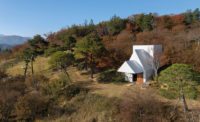Madrid, Spain
Behind the eye-catching design of the 969,000-square-foot Rey Juan Carlos Hospital in the Madrid suburb of M'stoles, Spanish architect Rafael de La-Hoz has created a therapeutic atmosphere, organizing the building around accessible atria that help orient patients and immerse them in a protective, inward-looking environment. These spaces also ensure that all patient areas have direct access to natural light.
De La-Hoz won a competition for the project in 2010, and it was designed and built in only 18 months for $140 per square foot, a low cost even for Spain. De La-Hoz cites the country's financial crisis and a lack of work in the construction industry as major reasons these goals were met.
The three-story base of the building is organized into a trio of parallel horizontal bands separated by two atria that run across its full width. One band, containing outpatient services, faces the street and features a line of eight light wells that bring daylight into corridors and waiting areas. Examining rooms look outside, where windows are shielded by a screen of continuous metal slats. Emergency services occupy a second band on the opposite side of the building and one level up, with ramped access for ambulances and dropoffs. Diagnostic equipment, operating rooms, and other technical areas are in the central band, for easy access from all areas, including the patient rooms above them.
Entries to the building from parking areas on both sides and from the street bring visitors into the main atrium. Despite its clean finishes and clear organization, the space is Piranesian in impact, crossed by bridges and with natural light sifting down from lofty circular skylights. The second atrium, lined on both sides with corridors for technical areas, is quieter and more isolated.
De La-Hoz and his team organized the curving drums above this base around accessible gardens, which are surrounded by glazed corridors and patient rooms. Each of the five floors contains a single nursing station, comprising a total of 260 beds. Within these drums, patients and visitors find themselves in a luminous, womblike space that includes them in a larger community of patients. The elevated ground plane of the gardens feels almost celestial. Sunlight filters through tilted roof canopies to create'together with the wood-plank floors, planters, and seating'an intimate and habitable space. In spirit these gardens are cloisters, places of repose, tranquility, and protection.
Patient rooms have expansive windows that overlook a suburban landscape. Even bathrooms have exterior windows. 'Usually the hotel-room type is extrapolated to the hospital,' says De La-Hoz. 'But you only sleep in a hotel; hospital rooms are lived in. And the bathroom is basic to this.' Outward-facing bathrooms give nurses greater visibility and access into the room.
Working with Spanish suppliers, the design team developed the curved glass sheath of the two drums as construction began. The resulting ventilated facade, supported by stainless-steel arms, is textured with a diamond pattern of dimpled glass panels'each configured with a surface of white ceramic frits that enable clear views from inside. Resting above the horizontal banding of the plinth, this milky glazing punctuated by hundreds of abstract 'eyes' glitters in the sun, a beacon of rescue for all those in the community seeking care.
PeopleOwner: Madrilenian Public Health Service. Department of Health, Autonomous Community of Madrid
Architect:
Personnel in architect's firm who should receive special credit: Engineer(s): GHESA Ingeniería y Tecnología, S.A.
Consultant(s): Other: Permasteelisa, Cricursa General contractor: O.H.L. (Obrascón Huarte Laín), S.A.
Photographer(s): Contact details:
Duccio Malagamba Renderer(s): Rafael De La-Hoz Arquitectos Size: 969,000 square feet Total Construction Cost: $126 million Completion Date: March 2012 |
ProductsTile: Porcelanosa, Discesur Glass: Cricursa, Control Glass Cladding: Permasteelisa, Cricursa, FERGA, Doval Building Furnishings: Actiú Flooring: Armstrong DLW Ibérica, Tarkett |











Post a comment to this article
Report Abusive Comment